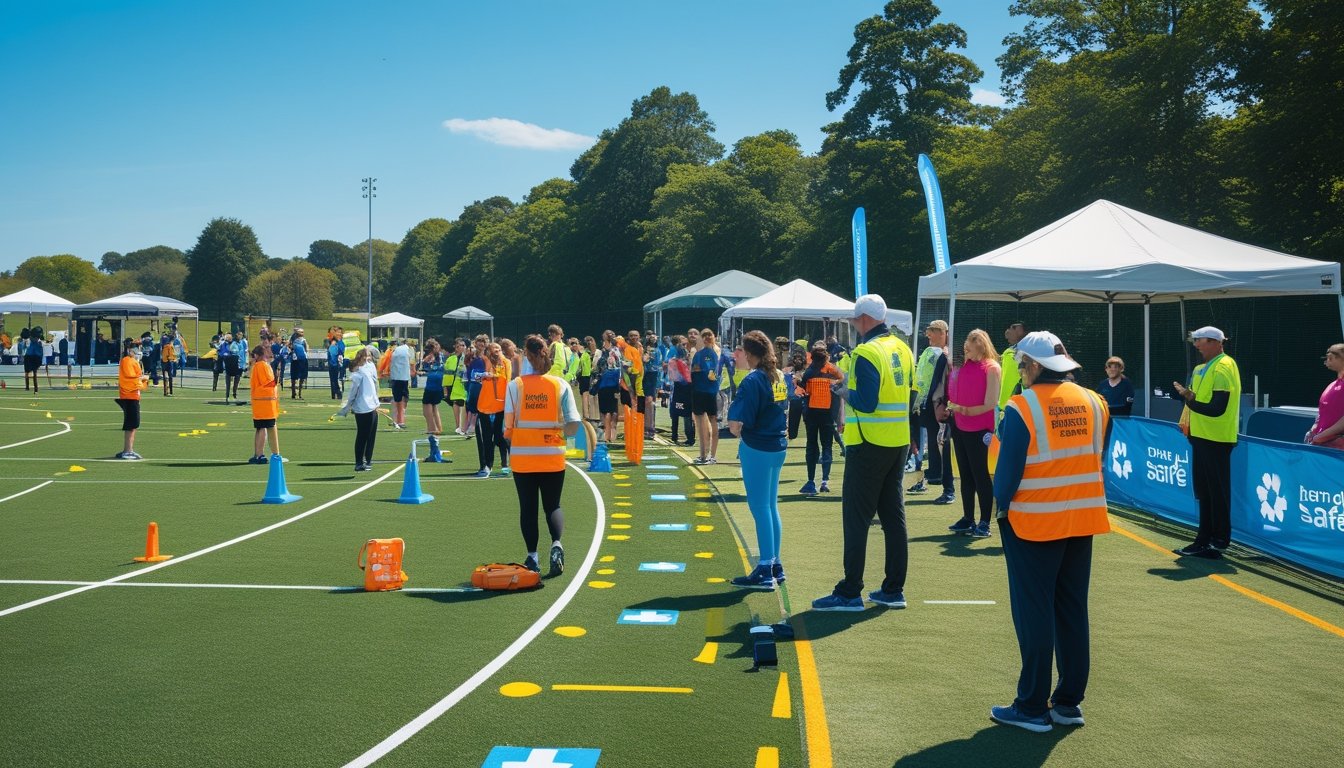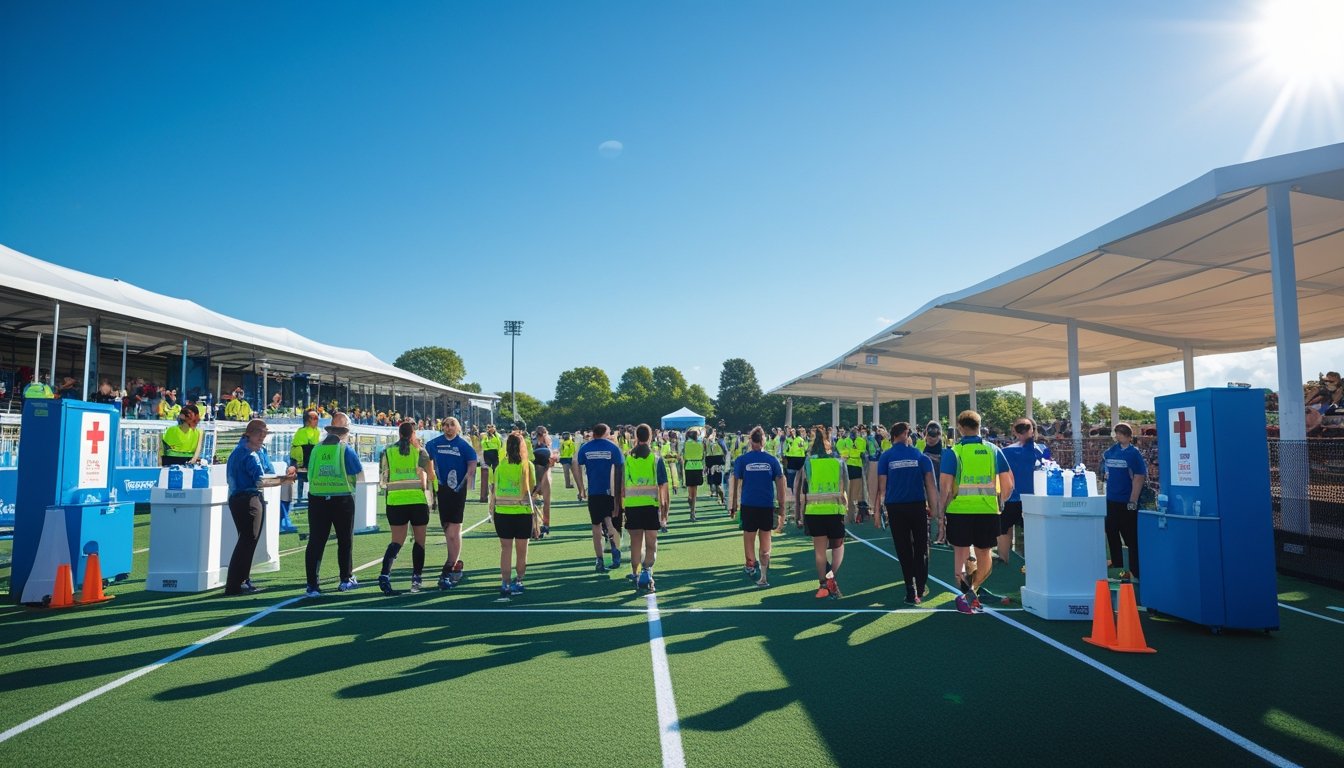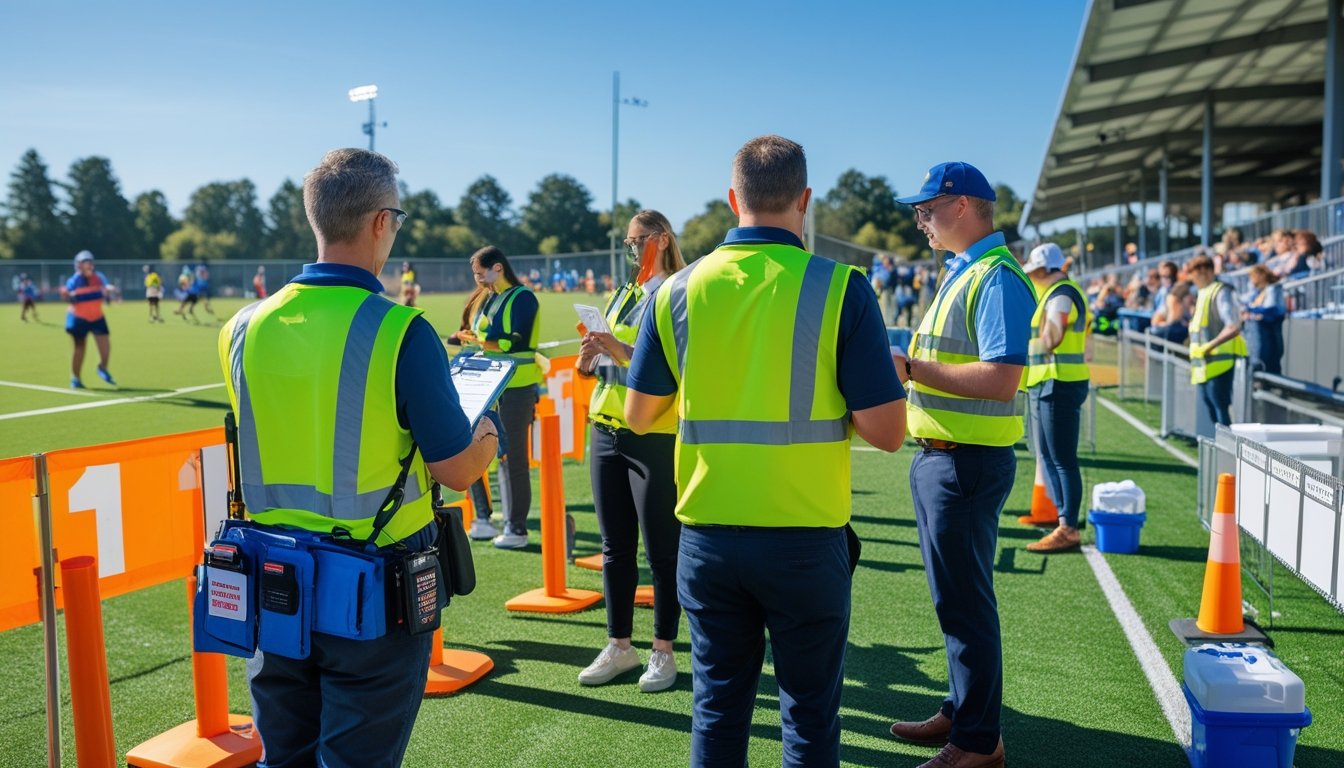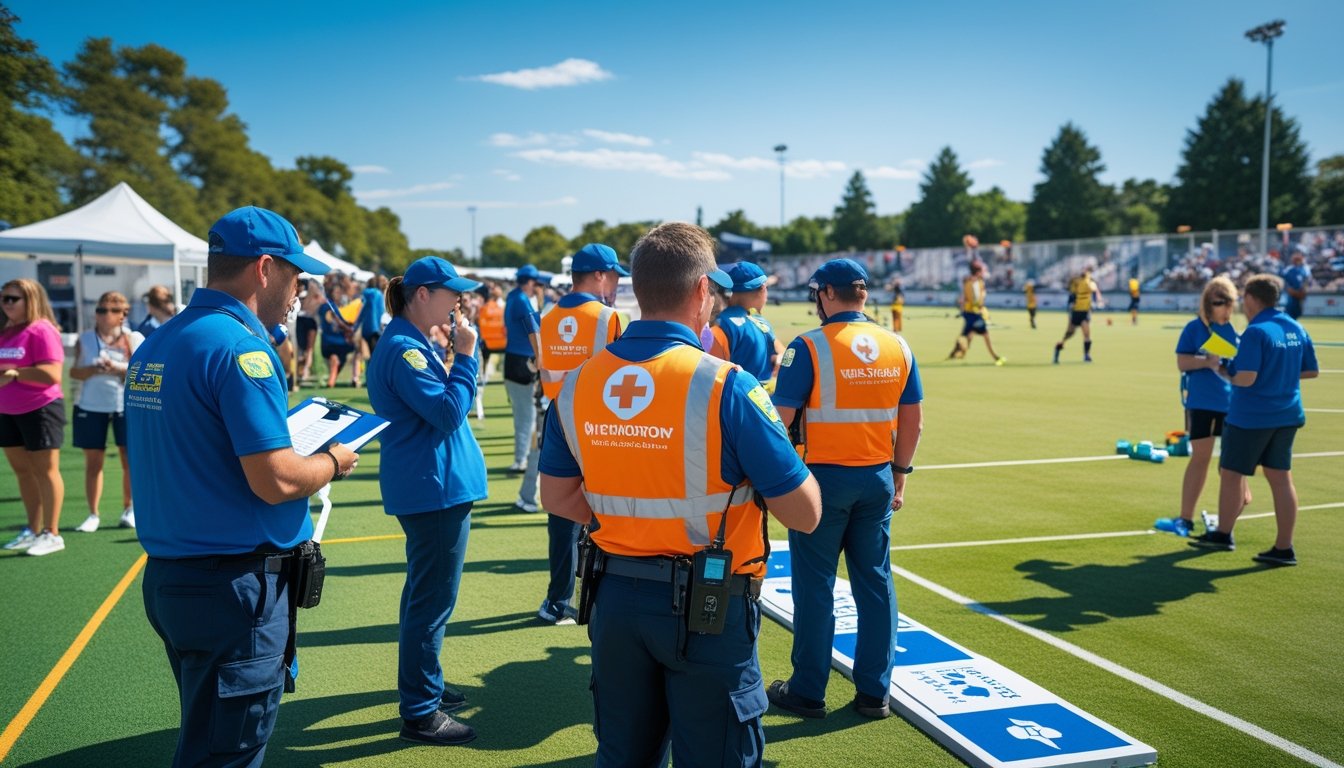Late updated: 26 Aug 2025 09:08
Written by: Emma Saunders
Tips For Hosting Safe Outdoor Sports Events: Essential Guidelines For Success
Planning a safe outdoor sports event requires careful attention to countless details. Ensuring the safety of participants, spectators, and staff is our foremost priority. As organisers, we navigate the challenges of unpredictable weather, varied terrain, and diverse crowds with precise strategies. The key to success lies in our ability to anticipate potential risks and implement sound measures to mitigate them.

Safety doesn't just happen; it is built into every part of our preparation. We develop comprehensive risk management plans tailored to the unique demands of each event. This involves a collaborative effort to involve professional security, engage medical support, and adhere to local regulations. Effective communication and solid coordination with our team are essential to bring about an event that is not only thrilling but also safe for everyone involved.
Outdoor sports events provide an opportunity to enjoy the beauty of nature while showcasing athletic skills. However, the dynamic nature of such gatherings requires us to be well-prepared with the right tools and best practices. By sticking to our core principles of thorough planning and diligent execution, we can ensure an exciting and secure experience for all attendees.
Key Takeaways
- Safety is prioritised in planning and managing outdoor sports events
- Comprehensive risk management and professional support are essential
- Effective communication ensures secure and enjoyable events
Key Safety Considerations for Outdoor Sports Events

Ensuring safety at outdoor sports events requires meticulous planning and adherence to established protocols. We must focus on satisfying legal safety requirements, carrying out risk assessments, creating emergency plans, and managing crowd control effectively. These elements are pivotal in maintaining seamless, secure events.
Understanding and Meeting Safety Requirements
To ensure outdoor sports meet safety standards, we need to thoroughly understand and comply with relevant regulations. These are dictated by local councils and sports governing bodies. Compliance involves obtaining necessary permits, ensuring venue safety, and checking that equipment meets standards.
Let's outline essential safety measures:
- Permits and Insurance: Secure all permits and ensure robust insurance coverage.
- Equipment Checks: Regular inspections of sports equipment to avoid accidents.
- Health and Safety Regulations: Adhere to all legislated guidelines.
These efforts redundantly safeguard participant welfare and ensure the event's legitimacy.
Conducting Risk Assessments for Outdoor Activities
Risk assessments are critical for identifying potential hazards. We must examine variables like weather, terrain, and equipment. Moreover, participants' health and capacity for physical activity need assessment.
Key steps in a risk assessment include:
- Identify Hazards: Pinpoint threats such as uneven ground or inclement weather.
- Evaluate Risks: Assess the impact and likelihood of each hazard.
- Implement Control Measures: Install barriers, post warning signs, and provide emergency shelters.
- Review and Revise: Continuously update the assessment with new findings or incidents.
By diligently conducting these assessments, we fortify safety at the event.
Establishing Comprehensive Emergency Procedures
Preparing for emergencies is crucial. Our emergency procedures must detail responses to potential incidents like extreme weather or medical emergencies. We should ensure staff are trained and equipment is functional.
Crucial Elements of an Emergency Plan:
- Evacuation Routes: Mark clearly and ensure accessibility.
- Communication Systems: Provide effective ways to alert attendees and staff.
- Emergency Personnel: Have qualified medical and safety staff on-site.
Having these measures assures quick response times to mitigate damages or injuries.
Crowd Control and Access Management
Managing crowds effectively prevents chaos and enhances safety. It involves regulating attendee movement and securing event access points. We must designate specific entry and exit points to control flow.
Strategies to ensure efficient crowd control include:
- On-Site Staff: Employing personnel to guide and monitor crowds.
- Barriers and Signage: Using barriers to organise queues and providing clear signage.
- Capacity Monitoring: Regularly assessing venue capacity to avoid overcrowding.
Implementing these strategies limits risks associated with large gatherings, enhancing safety for all participants.
Tools and Best Practices for Safe Event Management

To effectively manage a safe outdoor sports event, we need to focus on several core areas. Efficient communication using modern protocols ensures quick dissemination of information. On-site medical assistance remains vital to address emergencies promptly. In addition, comprehensive safety training for staff ensures preparedness for any situation.
Effective Communication Protocols and Technology
Communication is the backbone of event management. Utilising two-way radios and mobile apps facilitates instant updates and coordination among staff. Technologies like event management software help in assigning tasks and monitoring progress. These tools enhance responsiveness, reducing the risk of oversights.
Deploying digital signage and PA systems aids in mass communication. They ensure all attendees are informed about any immediate changes or emergencies. We also encourage real-time messaging apps, such as WhatsApp groups, to keep everyone connected. This multi-channel approach ensures seamless information flow, enhancing overall event safety.
Medical Emergencies and On-Site Medical Assistance
Having robust plans for medical emergencies is crucial. We ensure there's a first aid station at a central location. These stations must be equipped with basic medicines and emergency supplies. Certified medical professionals should be present to handle any critical situations that may arise during the event.
To enhance readiness, it’s important to have ambulance services on standby. We also need to have clear protocols for emergencies, ensuring all staff know who to contact and the steps to follow. All attendees should be informed about the location of medical services, making it easy to access help when needed.
Staff Safety Training and Preparedness
Training our staff effectively is non-negotiable. Conducting regular training sessions and drills prepares them for various scenarios. They need to be aware of evacuation procedures and crisis management, ensuring calm and controlled responses under pressure.
Equipping staff with knowledge about emergency equipment, like fire extinguishers and defibrillators, can save lives. Training in basic first aid and CPR ensures immediate assistance is available whenever required. Continual safety audits and assessments ensure preparedness, allowing us to address any safety concerns proactively. This comprehensive preparation empowers teams to act swiftly, safeguarding all event participants.
Frequently Asked Questions

When hosting outdoor sports events, ensuring safety is a crucial aspect. From evaluating potential risks to ensuring effective crowd control, various strategies need to be implemented for a successful event.
What are the essential safety considerations when organising an outdoor sports event?
Ensuring the venue’s safety involves checking infrastructure stability, accessibility, and emergency exits. Considering weather conditions and providing adequate shelter is crucial. It's important to have trained staff on-site to manage emergencies promptly.
Which strategies ensure effective crowd control at large-scale sports competitions?
Effective layout planning and signage are vital for guiding attendees seamlessly. Utilising barriers to manage the flow and employing trained security personnel can prevent overcrowding and ensure safety. Communication systems should be in place for alerting crowds in real-time.
How can risk assessments be optimised for outdoor sports event management?
Conduct thorough site inspections before the event to identify potential hazards. This includes assessing the terrain for slips and falls. Employ risk management software to monitor ongoing developments. Constant updates and checks are necessary for safety.
What are the best practices for emergency response planning at sports events?
Having a detailed emergency response plan, including evacuation routes and medical aid stations, is essential. Training staff members in first-aid and emergency protocols ensures swift action during critical situations. Coordination with local law enforcement and medical services is advised.
In what ways can sports event hosts facilitate accessibility and safety for attendees with disabilities?
Ensure that pathways and facilities are accessible and comply with disability standards. Providing clear signage and trained personnel to assist attendees with disabilities enhances the experience for all visitors. Offering specialised transport solutions can also increase accessibility.
How should communication with participants and spectators be managed to maintain safety during a sports event?
Effective communication systems such as PA systems and digital alerts should be in place. Regular updates about changes or safety instructions need to be relayed promptly. Having a clear point of contact for addressing concerns or queries assures attendees of their safety.
